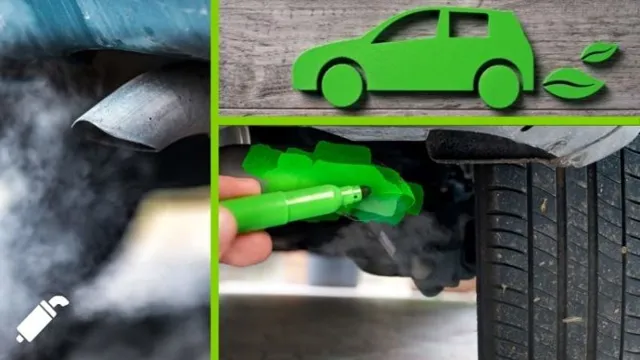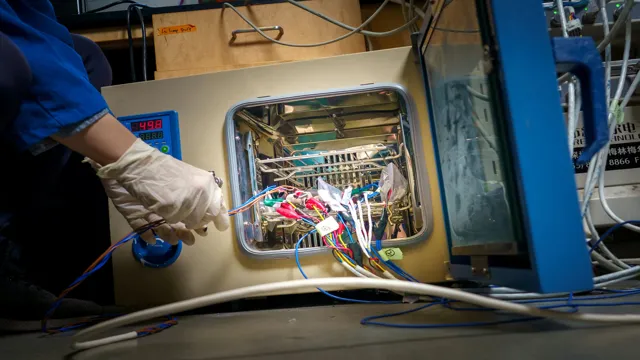Clearing the Smoke: Debunking the Myth of Tailpipes in Battery Electric Cars
If you’ve ever wondered why we need to reduce tailpipes on vehicles, the answer is simple. With increasing levels of air pollution and climate change becoming a significant issue, emissions from vehicles are a contributing factor. Luckily, the advent of battery electric cars provides an alternative solution that could help solve this problem.
In this blog post, we will explore the link between battery electric cars and tailpipes and how it affects the environment. We will delve into the workings of battery electric cars and how they differ from traditional combustion engine cars. Also, we will examine the environmental benefits of battery electric cars and what the future holds for this innovative mode of transportation.
So, let’s get started and explore how battery electric cars could make the world a cleaner place.
Tailpipe Emissions: An Introduction
When it comes to emissions, one of the main advantages of battery electric vehicles (BEVs) is that they don’t have tailpipe emissions. That’s because they don’t rely on combustion engines that burn fossil fuels to produce power, which is the primary source of pollutants like carbon monoxide, nitrogen oxides, particulate matter, and more. Instead, BEVs use rechargeable batteries to power an electric motor that propels them forward.
As a result, BEVs are a cleaner and more sustainable transportation solution that can help reduce air pollution and greenhouse gas emissions. However, it’s worth noting that BEVs still have an environmental impact, particularly in terms of their manufacturing process and the sources of electricity that power them. Nonetheless, the lack of tailpipe emissions is a significant advantage that makes BEVs an attractive option for those who want to reduce their carbon footprint and protect the environment.
What Are Tailpipe Emissions?
Tailpipe emissions refer to the exhaust that vehicles produce and release into the atmosphere. It’s a major contributor to air pollution. The tailpipe emissions originate from various sources including combustion of fuel and oil and can produce harmful gases like carbon monoxide, nitrogen oxides, and particulate matter.
These pollutants can have an adverse impact on the environment such as smog, acid rain, and climate change. The engines of vehicles are being continually refined to lower their emissions, and there are also regulations that dictate the acceptable levels of tailpipe emissions. In general, the lower the amount of emissions that a vehicle produces, the better it is for the environment.
Hence, it’s important that we continue to find cleaner and more efficient ways to power our cars and trucks.

Conventional Cars and Their Tailpipe Emissions
Tailpipe emissions are an unavoidable consequence of conventional cars. These emissions are a result of the combustion of gasoline, which produces a range of harmful gases that are pumped out of the car’s exhaust pipe and into the atmosphere. These gases include carbon monoxide, which is poisonous and can cause headaches, dizziness, and nausea, as well as nitrogen oxides, which can cause lung damage and contribute to smog.
Another gas commonly emitted is carbon dioxide, which is a greenhouse gas and a key contributor to climate change. The level of tailpipe emissions produced by a car depends on a range of factors, including the age and condition of the car’s engine, as well as the type of fuel the car uses. Despite the ongoing development of cleaner, more efficient engine technologies, tailpipe emissions remain a significant contributor to air pollution and climate change.
Battery Electric Cars: Do They Have Tailpipes?
Battery electric cars, or BEVs, are powered solely by electricity stored in their batteries. This means that they don’t have an internal combustion engine and, as such, do not require a tailpipe. So, the answer is no – BEVs do not have tailpipes.
Instead, they emit zero tailpipe emissions, making them an environmentally friendly alternative to traditional gas-powered vehicles. This lack of emissions not only benefits the environment, but it also results in lower maintenance costs for the owner, as there are no oil changes or other engine-related repairs required. Additionally, BEVs are often quieter and smoother to drive than their gas-powered counterparts, offering a unique driving experience that many people enjoy.
Overall, if you’re interested in reducing your carbon footprint and want to explore a cleaner automotive option, a battery electric vehicle is definitely worth considering.
The Straight Answer: No
No, battery electric cars do not have tailpipes. Since they do not rely on combustion engines to function, they do not produce any harmful emissions nor the usual pollutants associated with owning and operating traditional gas-powered vehicles. Instead, the batteries in electric cars store the electricity needed to power their electric motors, making them much more eco-friendly and sustainable in contrast to their fossil fuel-consuming counterparts.
Moreover, without tailpipes, electric cars produce less noise, which adds to their charm regarding their contribution to a cleaner environment. Non-tailpipe electric cars’ impact on the earth is drastically lower than that of gas-guzzling cars, and they are less prone to emissions-related issues such as smog and acid rain.
How Battery Electric Cars Work
If you’re wondering whether battery electric cars (BEVs) emit any tailpipe pollutants, the answer is no. Unlike conventional cars, which rely on internal combustion engines that produce emissions from the tailpipe, BEVs are powered by batteries that store electricity from an external power source. This means that there are zero tailpipe emissions from BEVs, making them highly desirable for their environmental benefits.
Instead of relying on fossil fuels, BEVs rely on electricity generated from clean sources such as solar or wind power. In short, BEVs are a great way to reduce our dependence on oil and reduce our carbon footprint, all while enjoying a quiet and emissions-free driving experience.
Why Tailpipe Emissions Are Harmful
One of the main benefits of battery electric cars is that they do not have tailpipe emissions. This is a significant advantage over traditional gasoline-powered vehicles, which emit harmful pollutants into the air. Tailpipe emissions contain a variety of harmful substances, including carbon monoxide, nitrogen oxides, and particulate matter.
Exposure to these pollutants can lead to a range of health problems, including respiratory issues, heart disease, and even cancer. As battery electric cars do not have an internal combustion engine, they do not produce these harmful emissions. Instead, they run on electricity stored in a battery, which can be recharged using renewable energy sources such as wind or solar power.
This makes battery electric cars an environmentally friendly alternative to traditional vehicles, as well as a healthier option for those living or working in areas with high levels of air pollution.
Health and Environmental Impacts of Tailpipe Emissions
Tailpipe emissions from vehicles are harmful to both our health and the environment. In fact, these emissions are one of the primary sources of air pollution in many cities around the world. They contain harmful chemicals such as nitrogen oxides, carbon monoxide, and particulate matter, which can cause respiratory issues like asthma, bronchitis, and lung cancer.
Additionally, these emissions are a significant contributor to global warming, as they release large amounts of greenhouse gases into the atmosphere. This can lead to a variety of negative impacts, including rising temperatures, sea level rise, and more frequent and intense extreme weather events. In order to mitigate the harmful effects of tailpipe emissions, it is important that we work to reduce our reliance on fossil fuels and shift towards more sustainable forms of transportation.
By doing so, we can help protect both our health and the environment.
Global Efforts to Reduce Tailpipe Emissions
Tailpipe emissions are one of the leading causes of air pollution and climate change, with harmful pollutants such as carbon monoxide, nitrogen oxides, and particulate matter being released into the atmosphere. These emissions not only contribute to poor air quality, but they also have negative health impacts on humans and wildlife. That is why global efforts are being made to reduce tailpipe emissions.
Governments around the world are implementing stricter emissions standards for vehicles, encouraging the use of electric and hybrid cars, and investing in public transportation systems. Car manufacturers are also taking steps to reduce emissions by developing more fuel-efficient engines and alternative fuel vehicles. By limiting tailpipe emissions, we can make the air we breathe cleaner and healthier for everyone.
Conclusion
No, battery electric cars do not have tailpipes because they don’t rely on burning fossil fuels to power their engines. In other words, they produce zero emissions and are kinder to the environment. So, while traditional cars may be giving off puffs of smoke, electric cars are whispering by silently, leaving behind nothing but the envy of bystanders.
“
FAQs
Do battery electric cars emit any emissions from the tailpipe?
No, battery electric cars do not have a tailpipe, and therefore do not emit any emissions from it.
How do battery electric cars produce power if they don’t have a tailpipe?
Battery electric cars have rechargeable batteries that power an electric motor, which drives the car’s wheels.
Can battery electric cars travel long distances without needing to recharge?
Despite advances in battery technology, most battery electric cars cannot travel as far as gasoline-powered cars on a single charge. However, some newer models can travel upwards of 300 miles before needing to be recharged.
How long does it take to recharge a battery electric car?
The time it takes to recharge a battery electric car depends on several factors, such as the capacity of the battery and the type of charging station used. In general, it can take anywhere from 30 minutes to several hours to fully recharge a battery electric car.






